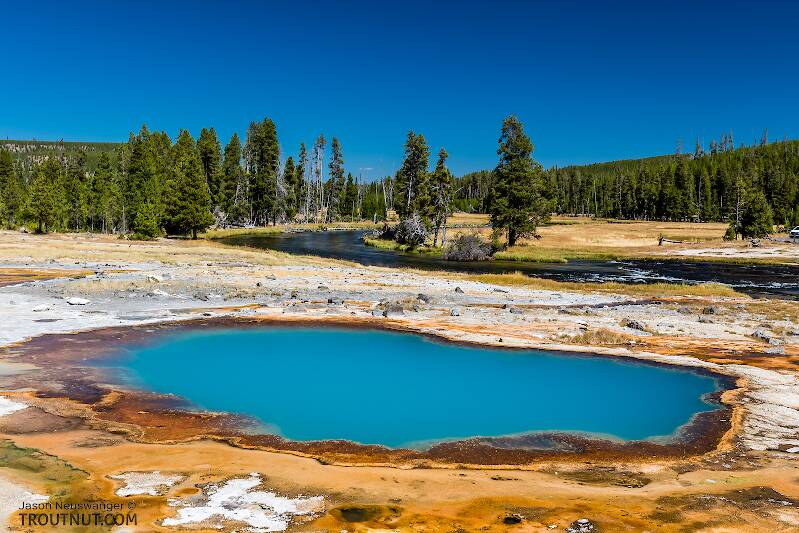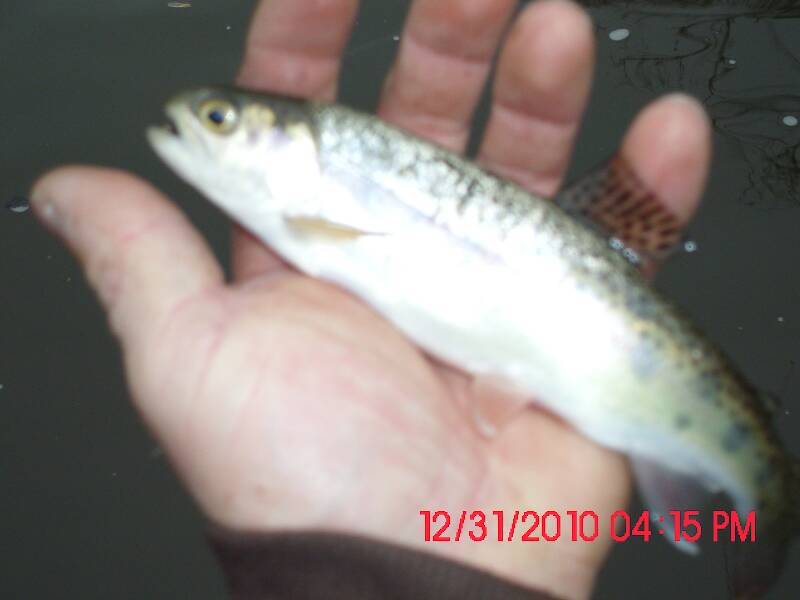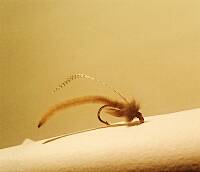
Salmonflies
Pteronarcys californica
The giant Salmonflies of the Western mountains are legendary for their proclivity to elicit consistent dry-fly action and ferocious strikes.
Featured on the forum


Troutnut is a project started in 2003 by salmonid ecologist Jason "Troutnut" Neuswanger to help anglers and
fly tyers unabashedly embrace the entomological side of the sport. Learn more about Troutnut or
support the project for an enhanced experience here.
Troutnut on Feb 10, 2011February 10th, 2011, 4:53 pm EST
Aren't you supposed to be studying, man?!
Nah, I passed my comps Tuesday. Now I'm supposed to be writing a paper. :)
You're almost colder than us, but not quite. We have been having a warm front lately... it got into the double digits above zero earlier.
Jason Neuswanger, Ph.D.
Troutnut and salmonid ecologist
Troutnut and salmonid ecologist
Oldredbarn on Feb 11, 2011February 11th, 2011, 1:29 am EST
Congrats! Now you get to stare at a blank page...Good luck!
Its only 8 degrees out now at 9:30am...It was cold last night!
Spence
Its only 8 degrees out now at 9:30am...It was cold last night!
Spence
"Even when my best efforts fail it's a satisfying challenge, and that, after all, is the essence of fly fishing." -Chauncy Lively
"Envy not the man who lives beside the river, but the man the river flows through." Joseph T Heywood
"Envy not the man who lives beside the river, but the man the river flows through." Joseph T Heywood
Oldredbarn on Feb 11, 2011February 11th, 2011, 5:10 am EST
People might think a stream can withstand some harvest it actually can't, especially if they underestimate how much other pressure it receives. It's a tricky balancing act: we have to acknowledge the fact that many systems can support some harvest, while promoting caution and a "better safe than sorry" attitude in people who might not realize what's acceptable harvest and what's not.
Jason,
Somewhere in here is a tongue-in-cheek response to Tim from Grayling where I mentioned a dinner I had with a couple fly tiers after a nearby show. One guy was a life long resident of Grayling and a good friend of Tim's, the other has fished the Au Sable since the mid-70's and is a retired biology teacher from Ohio. The conversation got around to the no-kill regs on the Au Sable and whether or not they have worked in any way.
Tim would know more of the details than I, but many years back the city of Grayling directed some of it's water system in to the river. They finally got around to correcting this and this event has been mentioned as having a big effect on the river. Prior to this time some of the water system may have included phosphates etc and actually increased the weed levels in the river...The fact that there seems to be less weeds in the river now is sometimes pointed to when we get anecdotal reports on the fishing from anglers.
During our dinner conversation the phrase "carrying capacity" came up and how this may impact the whole system from the aquatic insects on up to the lovely trout we like to hassle. This is what I was alluding to when I decried the lack of dough floating around in our state and how unlikely it may be that I will see some real science concerning the no-kill experiment on the two sections of the Au Sable where it exists.
In the past the Angler's of the Au Sable have funded some very nice studies, of one kind or another, but over the last 5-10 years all our capital is tied up in legal fees in an attempt to stop natural gas drilling near the Mason Tract and to stop a company from diverting filtered water from a polluted site from one water shed in to another, the Au Sables. Among other issues.
Years ago I went to the Michigan Fly Fishing Club to ask them for a donation to a project up on the Au Sable. They cut me a generous check but I was told by one of the board members then that no matter how much money we drop in to the Au Sable it will never be like a Montana stream. There may be something to what he said. Over the decades from the old CCC - Civilian Conservation Corps, to the Huron-Pines Watershed Committee, to the work done by the anglers' groups, the Angler's of the Au Sable, the various TU chapters etc and still we have complaints that the "good-old-days" are better.
Some of this we can write off as old-farts like myself being old-farts, but I really wish we had some real science to back up my standing out here on the frontline of the catch-and-release issue. I love "wild" trout and am not too fond of stockies and I feel that improved habitat makes sense. Having the no-kill sections on the Au Sable has given us a nice stock of wild fish...
But...
In the early 90's I was invited by the Ann Arbor Chapter of TU to help one of their committees that was looking in to starting a put-and-take program for trout on the Huron west of town. We got together a group of DNR folks, U of M's fisheries division, and the Huron Watershed Committee. The DNR folks said that their view is basically to put fish in habitats where they can live and reproduce and work on improving the habitat, not dropping fish in water that will only sustain them for the weeks before summer temps arrive...Just so us anglers can run around pretending we really got something here.
That stretch of the Huron has a catch-and-release rule in place for the smallmouth bass. It was developed as a lab for research for rules etc in the rest of the state...I told the U of M boys who developed it that it was really for their benefit while they lived in and around Ann Arbor, but who's complaining?! :)
We now have a fishery there that is sustainable, accessable, and down right fun...
I really don't know what the answers are. I don't know if one form of fishing is better than another, but I have spent a great deal of time wandering around Michigan streams my whole life and have seen the abuse that they have had to endure. I have found snagging rigs in the fly's only section of the Pere Marquette, watched canoes float through the catch-and-release sections of the Au Sable with guys tossing a Mepps Spinner around, watched poachers yank fish out of the same areas, dumped bait containers and beer cans and mono everywhere, throw all sort of shit in to the streams and farm boys who consider a certain fish to be a "garbage fish" toss it back up in the weeds on the bank...I think all these rascals need to be reined in a bit. Otherwise, as I also said elsewhere, its katie-bar-the-door. In my opinion it wouldn't take this crew very long to waste a stream and its inhabitants.
I know the bottom line is we are just fishing here and maybe I'm over thinking it...I just don't understand the resistance to a few rules designed to maintain a healthy population of wild trout...To the benefit of ourselves. What makes us humans incapable of seeing a bigger picture?
I was on the Huron one evening and watched a raft of tubers floating downstream stoned out of their minds tossing their empty beer cans up on the bank and under the bridge...When I asked them if they really wanted to float through a garbage pit the next time they decided to float the river I was told to "Go **** myself!" There was a time when I would of been more than happy to drowned each and every one of them..."Go Southend on their asses!" Like us boys from the south-end used to say...They were pathetic!
Spence
"Even when my best efforts fail it's a satisfying challenge, and that, after all, is the essence of fly fishing." -Chauncy Lively
"Envy not the man who lives beside the river, but the man the river flows through." Joseph T Heywood
"Envy not the man who lives beside the river, but the man the river flows through." Joseph T Heywood
Troutnut on Feb 11, 2011February 11th, 2011, 6:00 am EST
I know the bottom line is we are just fishing here and maybe I'm over thinking it...I just don't understand the resistance to a few rules designed to maintain a healthy population of wild trout...To the benefit of ourselves. What makes us humans incapable of seeing a bigger picture?
We're not all incapable of seeing the picture... just some. We'll always have to struggle against that group to protect resources.
To be sure, all my comments that "some harvest is OK" apply to areas where harvest is both legal and responsible. I support having C&R-only zones, especially on famous, high-pressure rivers, and I think there should be more of them.
Jason Neuswanger, Ph.D.
Troutnut and salmonid ecologist
Troutnut and salmonid ecologist
Benjlan on Feb 11, 2011February 11th, 2011, 11:55 am EST
Hey Jason and Spence,
Next time we see those people on the stream let's hand them a rod.
Not a Zebco 202, but the rod out of our hands. Let's show them how to cast, let's put them them on fish, let's show them what it is all about. Then after two hours pass and they think it's been 20 minutes maybe, just maybe they will understand. No more beer cans, no more birds nests of mono, no more abuse to our streams. They will then understand. If they do not, well there is no saving them.....and they will have to be put down:)
Ben
Next time we see those people on the stream let's hand them a rod.
Not a Zebco 202, but the rod out of our hands. Let's show them how to cast, let's put them them on fish, let's show them what it is all about. Then after two hours pass and they think it's been 20 minutes maybe, just maybe they will understand. No more beer cans, no more birds nests of mono, no more abuse to our streams. They will then understand. If they do not, well there is no saving them.....and they will have to be put down:)
Ben
Quick Reply
Related Discussions
Topic
Replies
Last Reply
3
Jan 22, 2013
by Jesse
by Jesse





